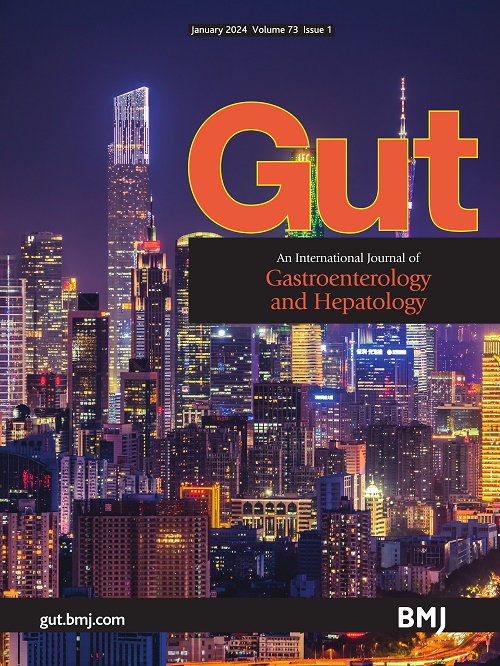KIF1Bβ通过运输和分泌FBLN5来抑制肝细胞癌,从而减弱整合素通路
IF 25.8
1区 医学
Q1 GASTROENTEROLOGY & HEPATOLOGY
引用次数: 0
摘要
我们之前的全基因组关联研究(GWAS)发现染色体1p36.22位点与肝细胞癌(HCC)的风险有关。目的鉴定该基因座的功能性致病变异和靶基因。设计两个独立的HCC病例对照人群,共包括1934例病例和1446例对照,用于验证1p36.22位点与HCC风险之间的关系。利用表达数量性状位点(eQTL)和eQTL- gwas共定位分析,鉴定了1p36.22位点的靶基因。在HCC细胞、裸鼠模型和条件敲除小鼠模型中评估靶基因对肿瘤发生的影响。结果我们证实了1p36.22位点与HCC风险之间的相关性(p=4.99×10−24),并揭示了该位点是激酶家族成员1B亚型β (KIF1Bβ)基因的eQTL。此外,我们在体外和体内证明了KIF1Bβ在HCC中发挥肿瘤抑制作用。在机制上,KIF1Bβ与货物Fibulin-5相互作用并介导其细胞内顺行运输和细胞外分泌,因此减少了整合素途径的激活。我们进一步鉴定了位于1p36.22的功能性致病变异rs61784580,该变异位于KIF1Bβ的启动子中,并以等位基因特异性的方式调节其表达。最后,我们观察到KIF1Bβ的下调使HCC细胞对整合素αv抑制剂西伦吉肽敏感。结论本研究揭示了HCC相关易感位点1p36.22的遗传和分子机制,为HCC治疗提供了潜在的新策略。数据可以在一个公共的、开放访问的存储库中获得。如有合理要求,可提供资料。数据可以在一个公共的、开放访问的存储库中获得。原始RNA-seq数据已存入Genome Sequence Archive数据库(GSA-Human: HRA005352)。如有合理要求,可提供其他数据。所有与研究相关的数据都包含在文章中或作为补充信息上传。[数据集]钟,[19][1]约翰霍普金斯大学,[20][2]Schröder等,[21][3]Schröder等,[22][4]Grinchuk等,[23][5]Gao等。[27] [6] [1]: # ref-19 [2]: # ref-20 [3]: # ref-21 [4]: # ref-22 [5]: # ref-23 [6]: # ref-27本文章由计算机程序翻译,如有差异,请以英文原文为准。
KIF1Bβ suppresses hepatocellular carcinoma by transporting and secreting FBLN5 to attenuate the integrin pathway
Background Our previous genome-wide association study (GWAS) identified that chromosome 1p36.22 locus contributes to the risk of hepatocellular carcinoma (HCC). Objective We aimed to identify the functional causative variant(s) and target gene(s) at this locus. Design Two independent HCC case–control populations, totally consisting of 1934 cases and 1446 controls, were used to validate the association between 1p36.22 locus and HCC risk. The expression quantitative trait locus (eQTL) and eQTL-GWAS co-localisation analyses were used to identify the target gene at 1p36.22. The effects of the target gene on tumourigenesis were assessed in HCC cells, nude mouse models and conditional knockout mouse models. Results We confirmed the association between 1p36.22 locus and HCC risk (p=4.99×10−24), and revealed that this locus is an eQTL of the kinesin family member 1B isoform β ( KIF1Bβ ) gene. Further, we demonstrated that KIF1Bβ plays a tumour suppressive role in HCC in vitro and in vivo. Mechanistically, KIF1Bβ interacts with the cargo Fibulin-5 and mediates its intracellular anterograde transport and extracellular secretion, therefore, reducing the activation of the integrin pathway. We further identified the functional causative variant rs61784580 at 1p36.22, which is located in the promoter of KIF1Bβ and regulates its expression in an allele-specific manner. Finally, we observed that downregulation of KIF1Bβ sensitises HCC cells to integrin αv inhibitor cilengitide. Conclusions Our findings shed light on the genetic and molecular mechanisms of the HCC-associated susceptibility locus at 1p36.22 and provide potential new strategies for the treatment of HCC. Data are available in a public, open access repository. Data are available on reasonable request. Data are available in a public, open access repository. The raw RNA-seq data have been deposited in the Genome Sequence Archive database (GSA-Human: HRA005352). Other data are available on reasonable request. All data relevant to the study are included in the article or uploaded as supplementary information. [dataset] Zhong,[19][1] Johns Hopkins University,[20][2] Schröder et al ,[21][3] Schröder et al ,[22][4] Grinchuk et al ,[23][5] Gao et al .[27][6] [1]: #ref-19 [2]: #ref-20 [3]: #ref-21 [4]: #ref-22 [5]: #ref-23 [6]: #ref-27
求助全文
通过发布文献求助,成功后即可免费获取论文全文。
去求助
来源期刊

Gut
医学-胃肠肝病学
CiteScore
45.70
自引率
2.40%
发文量
284
审稿时长
1.5 months
期刊介绍:
Gut is a renowned international journal specializing in gastroenterology and hepatology, known for its high-quality clinical research covering the alimentary tract, liver, biliary tree, and pancreas. It offers authoritative and current coverage across all aspects of gastroenterology and hepatology, featuring articles on emerging disease mechanisms and innovative diagnostic and therapeutic approaches authored by leading experts.
As the flagship journal of BMJ's gastroenterology portfolio, Gut is accompanied by two companion journals: Frontline Gastroenterology, focusing on education and practice-oriented papers, and BMJ Open Gastroenterology for open access original research.
 求助内容:
求助内容: 应助结果提醒方式:
应助结果提醒方式:


